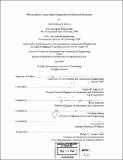| dc.contributor.advisor | Nesbitt W. Hagood, IV. | en_US |
| dc.contributor.author | Dunn, Christopher Thomas, 1971- | en_US |
| dc.contributor.other | Massachusetts Institute of Technology. Dept. of Aeronautics and Astronautics. | en_US |
| dc.date.accessioned | 2009-01-30T18:37:28Z | |
| dc.date.available | 2009-01-30T18:37:28Z | |
| dc.date.copyright | 2002 | en_US |
| dc.date.issued | 2002 | en_US |
| dc.identifier.uri | http://dspace.mit.edu/handle/1721.1/16851 | en_US |
| dc.identifier.uri | http://hdl.handle.net/1721.1/16851 | |
| dc.description | Thesis (Ph. D.)--Massachusetts Institute of Technology, Dept. of Aeronautics and Astronautics, 2002. | en_US |
| dc.description | Includes bibliographical references (v. 2, leaves 267-276). | en_US |
| dc.description.abstract | The integration of piezoelectric actuators into a structure can lead to an active structural surface that can adapt by bending or straining to different operational conditions. This can be used to tune desired properties of the active system to their optimal levels. Due to their fast response time, high bandwidth, and the level of force that the actuator can apply, it has been proposed that monolithic piezoelectric materials be used for active structural control. Monolithic piezoelectric materials for planar actuation have several drawbacks including: (a) use of the lower 3-1 actuation for planar actuation, (b) low strain before failure, (c) inability to conform to curved surfaces. Active Fiber Composites (AFCs) have been developed to address some of these shortcomings of monolithic piezoceramic materials. AFCs are thin composite plies comprised of unidirectional piezoelectric fibers imbedded in a thermoset matrix. An electric field is supplied to the fibers by use of an interdigitated electrode pattern adhered to either side of the AFC. The benefits of AFCs include: the interdigital electrode design uses 3-3 actuation offering increased levels of actuation, AFCs allows for anisotropic planar actuation, the AFCs matrix provides load transfer and load distribution, AFCs allows for coverage of curved shapes. A major drawback of the AFCs with PZT-5A fibers is that the level of actuation is 60% lower than that of the 3-3 actuation of monolithic PZT-5A. This is due primarily to a small layer of low dielectric matrix material that is trapped between the electrodes and the high dielectric fibers during manufacturing. | en_US |
| dc.description.abstract | (cont.) This dielectric mismatch causes a large voltage drop in the matrix thereby reducing actuation. A method that has been developed to reduce this matrix gap, and thus increasing actuation, is to transfer the electrode pattern onto plastic sheets, and heat and press the sheets around the fibers to make Thermoplastic Active Fiber Composites (tmAFCs). tmAFCs also have simpler processing when compared to AFCs and are reshapeable. The focus of this research is to analyze, manufacture, and test tmAFCs to be used in structural control applications with the goal of producing high quality and high performance actuators. | en_US |
| dc.description.statementofresponsibility | by Christopher T. Dunn. | en_US |
| dc.format.extent | 2 v. (276 leaves) | en_US |
| dc.language.iso | eng | en_US |
| dc.publisher | Massachusetts Institute of Technology | en_US |
| dc.rights | M.I.T. theses are protected by
copyright. They may be viewed from this source for any purpose, but
reproduction or distribution in any format is prohibited without written
permission. See provided URL for inquiries about permission. | en_US |
| dc.rights.uri | http://dspace.mit.edu/handle/1721.1/16851 | en_US |
| dc.rights.uri | http://dspace.mit.edu/handle/1721.1/7582 | en_US |
| dc.subject | Aeronautics and Astronautics. | en_US |
| dc.title | Thermoplastic active fiber composites for structural actuation | en_US |
| dc.type | Thesis | en_US |
| dc.description.degree | Ph.D. | en_US |
| dc.contributor.department | Massachusetts Institute of Technology. Department of Aeronautics and Astronautics | |
| dc.identifier.oclc | 51540524 | en_US |
